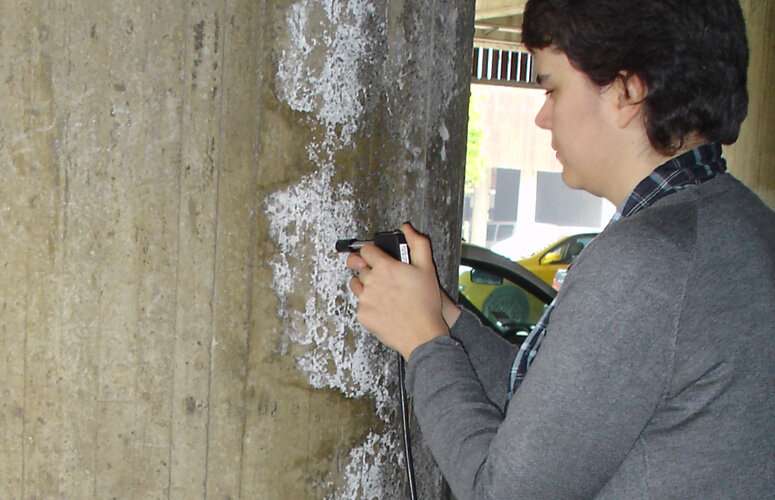Analyzing biological and chemical damage on 20th-century construction materials

It is customary for the research conducted in the IBeA research group in the UPV/EHU's department of Analytical Chemistry to be approached from a multidisciplinary perspective. One of the group's lines of work is the diagnosis and restoration of historical and cultural heritage for which spectroscopic analytical techniques are used. Although the group's research has until now focussed on historical monuments, now they have begun to study the origin and types of deterioration of a range of synthetic materials used in 20th-century buildings.
New construction materials are made up of synthetic materials featuring concrete, reinforced concrete, mortar and bricks. Once the work has been completed, the materials are at the mercy of the environment: the degrading agents in the surrounding area, such as acid gases in the atmosphere, water seepage, and lichens, among other things, can cause physical, chemical and biological damage. "The increasing contamination of the environment, the atmosphere and aquatic media is clear," said the researcher Iratxe Ibarrondo, "and we wanted to find out the effect exerted by chemical agents emerging from contamination and materials and the type of compounds that are formed as a result of chemicals reacting with each other."
The high-resolution spectroscopic analysis techniques used by the IBeA research group are essential when characterizing not only the original compounds of the stone materials but also the compounds formed as a result of deterioration processes. Raman analyses made in situ in the buildings have allowed the use of this technique to be proposed as a protocol to diagnose the type of environmental damage affecting 20th-century buildings in the process of refurbishment and renovation. Furthermore, by means of analyses conducted with greater resolution in the lab, they have been able to determine the types of damage found in new construction materials as well as the way in which they occurred. "We have managed to identify many different degradation compounds," explained the author of the research.
Method for measuring environmental contamination based on lichen pigments
In addition, "we analyzed the effects that can be caused by lichens or biological agents in these materials; the kind of reactions they cause or which take place in their presence as well as the damage that can be detected in the materials. The fact is that materials of this type tend to be in a very poor condition and display serious degradation problems," added Ibarrondo. That way they managed to establish that lichens play an active role in biodegradation processes: they discovered that they absorb different types of atmospheric particles, incorporate them into their metabolisms and synthesize new biominerals (minerals not found in the original stone substrate).
Finally, by using carotenoid pigments from the lichens, they developed a new method of measuring the degree of environmental contamination. "We established that lichens are highly resistant in contaminated environments, and in addition, the carotenoids they synthesize when contamination levels change and when greater degrees of oxidation are reached," explained Dr. Ibarrondo.
In the researcher's view, "this research has opened up new paths, mainly ones relating to biological agents. They can be analyzed better and more deeply and under no circumstances should they be underestimated because they cause significant damage." The research group collaborates with professionals in architecture, and "we saw that it is possible to establish this collaboration in the form of a protocol." Ibarrondo is hoping that, depending on the case, when a building project is designed, there will be a possibility of receiving advice about the effects exerted by the environment on the materials. "Building professionals see the type of deterioration the materials undergo, but we analytical chemists can determine the problem with greater precision. But that will be the next step; it is not yet reality."
More information: Iratxe Ibarrondo et al, Portable Raman can be the new hammer for architects restoring 20th‐century built heritage elements made of reinforced concrete, Journal of Raman Spectroscopy (2020). DOI: 10.1002/jrs.5959
Provided by University of the Basque Country




















